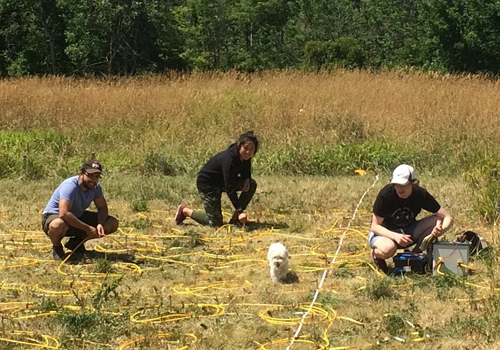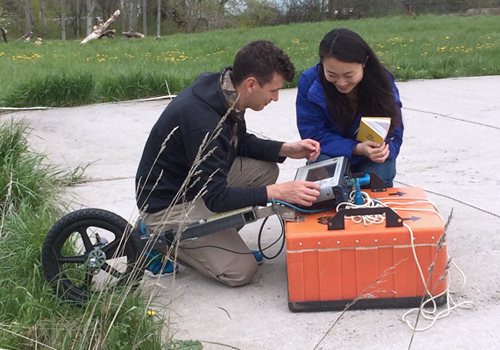Centuries ago, market shoppers were warned against buying a pig in a poke. It’s an old-fashioned phrase that is still good advice today: know what you’re buying because a pig in a poke may be no pig at all.
Homicide detectives looking for buried bodies face a somewhat similar quandary. They maybe received a tip that there’s a body in that field somewhere but not its precise location. And while the shopper could simply peek inside the poke (sack) to be sure it’s a pig in there and not something of lesser value, the detectives need to be certain that hidden below ground are human remains. That’s where several teams of undergraduate students in the Department of Earth Sciences at U of T – and some dead pigs – come in.
Pigs a good substitute for humans
In June 2012, 24 pigs and other miscellaneous items were buried in a farmer’s field near Toronto. For the next five years, groups of students measured changes in the soil around the objects over time and through the four seasons. It was all part of an experiment to figure out the best methods to locate buried murder victims and the items associated with foul play. Pigs wrapped in fabric are effective stand-ins for humans because they decompose much like people do and are of similar sizes.
Almost 20 students worked with professor Charly Bank of the Department of Earth Sciences to develop procedures for locating such burials, and monitor decomposition of the pigs using geophysical methods, with the results to be compared with analyses done by a forensic team from the University of Ontario Institute of Technology.
“It sounded like something you would see on a forensic TV show,” said Shelly Zhang, a human biology and nutritional sciences student who took part. “It was very different from lab-heavy research. You get to manipulate the data but also visit the actual research site.”
The project was a multi-year offering of the Faculty of Arts & Science’s Research Opportunities Program (ROP), which enables undergraduates to gain valuable hands-on experience under the close direction of an established faculty researcher. Bank, a near-surface geophysics specialist who has led ROP projects with students since 2007, had learned about the buried bodies test site and saw an ideal opportunity for U of T students to contribute and hone their research skills in the process.
Hands-on experience, new skills and perspectives
Students were involved with all aspects of data acquisition – initially one field day every other month, and evolving to bi-weekly visits in the final year – and analysis. They attained skills in using various geophysical methods such as ground-penetrating radar, magnetometry in the search for metal objects, and resistivity, which involves injecting an electric current into the ground to enable the measurement of soil disturbances, objects or fluids that disrupt the current’s flow.
“Field research was completely new to me when I started this project,” said pharmacology and immunology student Jodie Lunger. “Unlike a molecular biology lab, the instruments we used were often large and heavy, which I was not expecting. It really is a team effort out in the field, and I gained an appreciation for the people that do field research regularly.”

For Soho Shim, who credits her secret childhood desire to be an archeologist or detective with leading her to the project, the difference between field work and theory was striking. “I learned that field research is about approximation,” she said. “There are numerous factors which let the result deviate from the ideal classroom model. As a math and physics student, it was hard to accept the discrepancy between the field result and the model.
“But at the end of the day, explaining such discrepancies was the highlight of the project.”
Bank was pleased to show how methods used in earth sciences could bolster the efforts of law enforcement officials in searches for missing persons.
“Finding clandestine burials of murder victims, weapons, drugs or money is very difficult,” he said. “Though visual inspections, trained sniffing dogs, and probing sticks are still the methods of choice, geophysical methods provide an additional avenue.
“It is important to try all methods to see how they may work in different environments,” Bank added. “There are body farms in the United States and Australia, but environmental conditions in southwestern Ontario such as climate and soil compositions are different, so we can expect results to differ.
Mentorship from experienced researchers

An average of 200 students enroll in ROP courses every year, assisting faculty members on a wide variety of projects spanning nearly all disciplines in the Faculty of Arts & Science. Bank said he has been continually impressed with the dedication and energy his ROP students bring, and their ability to produce good research results at such an early stage in their careers.
Lunger attributes student success in the program to the careful way ROP courses are structured.
“The experience of working one-on-one with one of my professors was a huge part of the many benefits of working on this project,” she said. “It was easy to get direct feedback on my work, and create a relationship with my peers and Professor Bank.”
Eligible students wishing to participate in the Research Opportunities Program during the 2018 summer term and 2018-19 fall-winter terms can submit applications until Monday, June 4.

